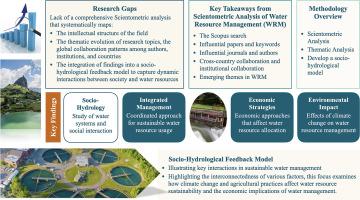澳大利亚水资源管理研究的趋势、模式和未来方向:从科学计量学的见解到动态社会水文反馈模型
引用次数: 0
摘要
水资源管理的重点是有效和可持续地分配、利用和保护水资源,以满足当前和未来的需求,减轻环境影响,同时确保生态系统和社区的复原力。尽管关于澳大利亚水资源管理的文献越来越多,但缺乏全面的分析,系统地描绘其知识结构、主题演变和全球合作模式,为未来的研究方向提供信息。本研究利用来自Scopus数据库的数据,对2000年至2024年的水资源管理研究进行了科学计量学分析。分析的关键领域包括引文趋势、共被引模式、国际合作动态、关键词共现和书目耦合,提供了研究景观的整体视图。该研究确定了被引用次数最多的10篇期刊文章,突出了Malone(2009)和Willis(2011)等开创性作品以及Zhang(2020)和Gao(2017)的近期有影响力的研究,反映了当前的研究趋势。共引分析揭示了主题集群,包括立法框架,如“2000年水资源管理法(NSW)”和理论贡献,如奥尔森的“集体行动的逻辑”。合作分析揭示了澳大利亚、美国、中国和德国之间的重要合作,与中国的合作关系显著增加。关键词共现分析确定了三个主要主题:“澳大利亚水资源管理”、“区域水资源管理”和“气候对水资源的影响”,重点关注墨累-达令盆地等地区。书目耦合突出了一些期刊的跨学科研究。据我们所知,这项研究是澳大利亚第一个全面的、决定因素导向的文献计量学和主题地图。这项研究填补了这一空白,它提供了一个新颖的、具体国家的、数据驱动的澳大利亚水资源管理研究景观地图,为未来的学术努力提供了一个基准。本研究提出了一个动态的社会水文反馈模型,将可持续水资源管理、综合经济和农业实践及其对水资源可持续性和生产力的影响等几个变量联系起来,同时考虑气候变化和地下水枯竭作为调节因素。这一分析为水资源管理的发展和合作趋势提供了关键见解,指导了未来的研究。本文章由计算机程序翻译,如有差异,请以英文原文为准。

Trends, patterns, and future directions in water resources management research in Australia: From scientometric insights to a dynamic socio-hydrological feedback model
Water resources management focuses on the efficient and sustainable allocation, use, and conservation of water resources to meet both current and future demands, mitigating environmental impacts while ensuring the resilience of ecosystems and communities. Despite the growing body of literature on water resources management in Australia, there is a lack of comprehensive analysis that systematically maps its intellectual structure, thematic evolution, and global collaboration patterns to inform future research directions. This study performs a Scientometric analysis of water resource management research from 2000 to 2024 using data from the Scopus database. Key areas of analysis include citation trends, co-citation patterns, international collaboration dynamics, keyword co-occurrences, and bibliographic coupling, offering a holistic view of the research landscape. The study identifies the top 10 most-cited journal articles, highlighting seminal works such as Malone (2009) and Willis (2011) and recent impactful studies by Zhang (2020) and Gao (2017), reflecting current research trends. Co-citation analysis reveals thematic clusters, including legislative frameworks like the "Water Management Act 2000 (NSW)" and theoretical contributions like Olson’s "Logic of Collective Action". Co-authorship analysis uncovers significant collaborations between Australia, the United States, China, and Germany, with a notable increase in partnerships with China. The co-occurrence analysis of keywords identifies three primary themes: "Water Resource Management in Australia", "Regional Water Management", and "Climate Impact on Water Resources", focusing on areas like the Murray-Darling Basin. Bibliographic coupling highlights a few journals to interdisciplinary research. To the best of our knowledge, this study is the first comprehensive, determinants-oriented bibliometric and thematic mapping of WRM in Australia. This study fills that gap by offering a novel, country-specific, data-driven mapping of the Australian WRM research landscape, providing a benchmark for future scholarly efforts. This study proposes a dynamic socio-hydrological feedback model linking several variables including sustainable water management, integrated economic and agricultural practices, and their impacts on water sustainability and productivity, while accounting for climate change and groundwater depletion as moderating factors. This analysis provides key insights into the development and collaboration trends in water resource management, guiding future research.
求助全文
通过发布文献求助,成功后即可免费获取论文全文。
去求助

 求助内容:
求助内容: 应助结果提醒方式:
应助结果提醒方式:


